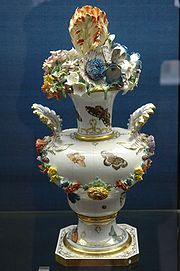
Nymphenburg Porcelain Manufactory
Encyclopedia

German language
German is a West Germanic language, related to and classified alongside English and Dutch. With an estimated 90 – 98 million native speakers, German is one of the world's major languages and is the most widely-spoken first language in the European Union....
: Porzellanmanufaktur Nymphenburg), manufacturer of Nymphenburg porcelain, is situated in the Nymphenburg Palace
Nymphenburg Palace
The Nymphenburg Palace , i.e. "Nymph's Castle", is a Baroque palace in Munich, Bavaria, southern Germany. The palace was the main summer residence of the rulers of Bavaria.-History:...
in Munich
Munich
Munich The city's motto is "" . Before 2006, it was "Weltstadt mit Herz" . Its native name, , is derived from the Old High German Munichen, meaning "by the monks' place". The city's name derives from the monks of the Benedictine order who founded the city; hence the monk depicted on the city's coat...
, capital of Bavaria
Bavaria
Bavaria, formally the Free State of Bavaria is a state of Germany, located in the southeast of Germany. With an area of , it is the largest state by area, forming almost 20% of the total land area of Germany...
, and since the mid-eighteenth century has been manufacturing porcelain of high artistic value.
History
After his accession in 1745 Maximilian III Joseph, Prince-Elector of Bavaria, commanded the establishment of manufacturing companies in order to bail out the state finances. From 1747 attempts were made to manufacture porcelain and at the end of that year the former Neudeck Castle in the area now the Munich suburb of Au-Haidhausen was made available for that purpose. Up to 1754 the experiments were a miserable failure and lost considerable amounts of money, but in that year the efforts to manufacture porcelain finally began to succeed. In the same year the rococo porcelain sculptor Franz Anton BustelliFranz Anton Bustelli
Franz Anton Bustelli was a Swiss-born German modeller for the Bavarian Nymphenburg Porcelain Manufactory from 1754 to his death in 1763...
came to work at the factory. In 1755 the factory received its first commission from the Bavarian court and in 1756 came the first success in painting the porcelain in colour. The management of the jurist and entrepreneur Count Sigmund von Haimhausen from 1758 ensured that the factory was placed on a sound commercial footing. By 1761 it had moved to the Nymphenburg Palace, where it still is today.
Among the great artists who followed Bustelli were Dominikus Auliczek the elder (1734-1804) and Johann Peter Melchior
Johann Peter Melchior
Johann Peter Melchior was a German porcelain modeller.Melchior was born in Lintorf. He was interested in art from an early age and was apprenticed to a sculptor in Düsseldorf. He made a name for him self in the porcelain trade and was named Modellmeister at the acclaimed Höchst porcelain factory...
. A great promoter of the works was Ludwig I
Ludwig I of Bavaria
Ludwig I was a German king of Bavaria from 1825 until the 1848 revolutions in the German states.-Crown prince:...
, who gave them many commissions. Particular favourites were dinner services with copies of famous paintings or with Bavarian landscapes in an antique style.
In 1822 Friedrich von Gärtner
Friedrich von Gärtner
Friedrich von Gärtner was a German architect.Gärtner and Leo von Klenze are the most well known architects of Bavaria during the reign of Ludwig I. His architecture was generally in the Romanesque style and much to the king's taste...
, the fashionable architect, was appointed artistic director of the factory. In the middle of the 19th century its financial position deteriorated to the extent that in 1856 all artistic production was halted and it was decide to privatise the factory. It was leased out for the first time in 1862 and its focus shifted to the production of technical, medical and sanitary porcelain goods.
In 1887 Albert Bäuml (1855-1929) took a lease of the factory. His aim was to regain the previous high artistic level of the factory's products: it was Bäuml, for example, who "rediscovered" Bustelli. This aim was realised at around the turn of the 19th and 20th centuries and besides historical copies, elegant Jugendstil ceramics were developed.
Since 1975 the factory has been leased by the Bavarian government
Bavaria
Bavaria, formally the Free State of Bavaria is a state of Germany, located in the southeast of Germany. With an area of , it is the largest state by area, forming almost 20% of the total land area of Germany...
to the Wittelsbach Compensation Fund
Wittelsbach
The Wittelsbach family is a European royal family and a German dynasty from Bavaria.Members of the family served as Dukes, Electors and Kings of Bavaria , Counts Palatine of the Rhine , Margraves of Brandenburg , Counts of Holland, Hainaut and Zeeland , Elector-Archbishops of Cologne , Dukes of...
(Wittelsbacher Ausgleichsfonds).
The Nymphenburg Palace also accommodates the Nymphenburg Porcelain Museum (the Bäuml Collection). Guided tours through the factory can be arranged by prior appointment. Nymphenburg Palace is known to have been the working place of artists and sculptors like Hanns Goebl
Hanns Goebl
Hanns Goebl was a Bavarian sculptor who worked for the Nymphenburg Porcelain Factory. During the 1930s and 1940s he produced several works of art for the Nazis....
and Franz Anton Bustelli.
External links
- Nymphenburg Porcelain Manufactory official website

